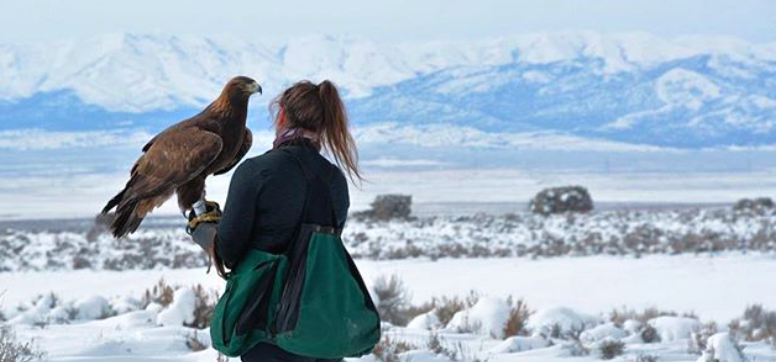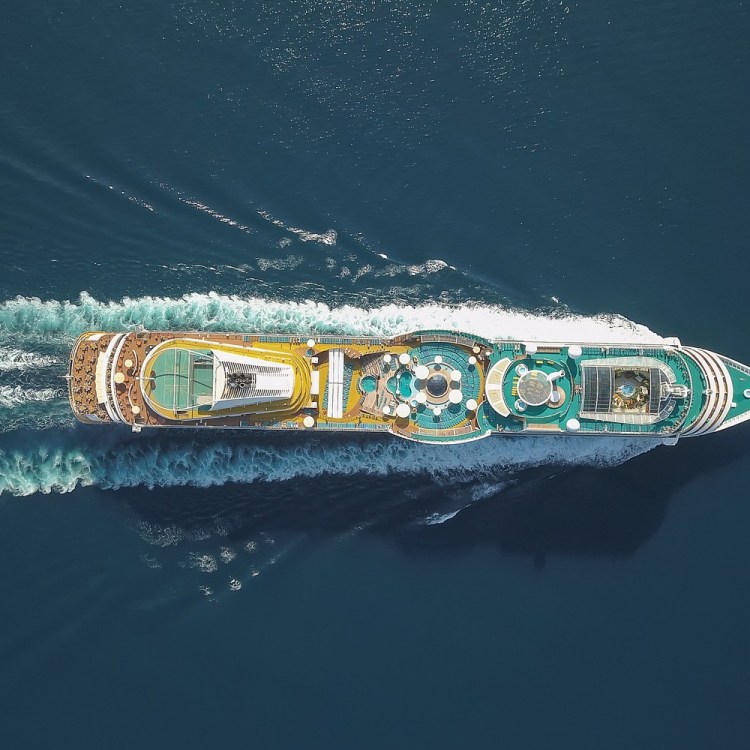In the most basic description of her passions, one could say that Lauren McGough appreciates flight. She is a skydiver and pilot in training. But on the more exotic side of the spectrum, she is also a connoisseur of the mechanics, energy and honest-to-goodness bewitchment of patience cultivated proximity to the greatest flight masters of our planet…birds of prey. Lauren is a falconer and anthropologist who has spent her life since the age of 13 dedicated to the craft of working with raptors. From wild birds to animals in rehab, she has mastered the technique of hunting in tandem with nature. Which is not the same “using” animals to hunt. As she describes it, these birds don’t need her in any way. So, to develop a bond and a symbiotic partnership with them transcends the basics of interspecies cooperation and takes the experience to a level that needs to be felt to be properly understood.
Falconry is recognized by UNESCO as an Intangible Cultural Heritage. It has been in practice on our planet for thousands of years and is one of the most ancient forms of hunting.
Today it is still practiced on six continents and has been an instrumental tool in our understanding of birds of prey and the development of conservation programs that benefit their continued survival.
Lauren’s falconry has taken her to the most remote corners of the world to learn from cultures that have fine tuned hunting with raptors since the dawn of time. In Mongolia, the artful practice originated between 4,000 and 6,000 B.C.E. In 2009, Lauren was awarded a Fulbright Scholarship to live with these nomadic people. Lauren learned the ancient mastery of hunting with eagles through living with the Kazakh Berkutchi. She spent years with a family of nomadic herders and apprenticed under Kazakh eagle masters who happily passed on the legacy of their ancestors to a passionate girl from Oklahoma. They taught her both the artistry necessary to succeed and the respect for the sacred connection to the birds.
She now applies this knowledge to rehabilitating injured eagles in the United States and South Africa. In a form of partnership rather than domestication, she helps the eagles sharpen their skills and strengthen their bodies for a greater chance at survival. Not just a form of art or tool for hunting, these falconry techniques are aiding in captive breeding of endangered raptors and helping us to understand how these magnificent animals respond to everything from environmental stress to habitat change and human encroachment.
Gaining experience is not just a matter of practice, but also of science and education. Lauren has a B.S in Zoology and a B.A. in International Studies. She is the executive director of the Falconry Fund, a nonprofit organization dedicated to cultural outreach and raptor conservation.
In addition she is an anthrozoologist traveling the world to study the ancient relationship between humans and birds of prey.
It would be a desperate waste of a fantastic pun opportunity not to say that Lauren has indeed earned her wings.
Q: Passion is a powerful driving force for people. How did yours develop and mold who you are and what you do?
LM: When I was a kid I was always fascinated by birds and predators in particular. I remember being intensely curious about the wild lives of eagles: what did they do all day? But chance encounters in the wild weren’t enough for me, and neither was seeing them in a zoo environment. I wanted to be right there with them while they flew and hunted. I always thought falconry was impossible, an old sport practiced by medieval aristocracy. In 2000, when I was 13, I stumbled across the book “A Rage for Falcons” by Steve Bodio in the library, a memoir of a falconer in the 20th century. That was it—I instantly had this conviction that I had to become a falconer. The next year I passed my license exam, my dad built an aviary for me, I found a mentor, and trained my first raptor, a red-tailed hawk.
It was everything I hoped for and more. I would get off the school bus and would walk with my red-tailed hawk to the woods a few blocks away. She followed me from tree to tree as I searched for rabbits for her to chase. When a rabbit ran across a meadow, she’d stoop from the treetop, falling like a stone in an attempt to catch it. She often missed, but was also often successful, and I would let her eat part of the rabbit as her well-earned reward. The other part I took home to cook myself. I’ve never been very good at cooking game, but the pleasure of getting dinner the very, very hard way was far more important to me.
Q: What most people understand of falconry is just the tip of the iceberg…holding a bird of prey on ones arm. It’s much more complex than that. Can you elaborate?
LM: What I find endlessly fascinating about the tradition of falconry is that there is no domestication involved—this is a wild animal that you must tame through your own ingenuity. Raptors aren’t social animals and don’t need you_all reinforcement must be positive, and you must slowly convince this wild animal that being with you is worthwhile. It’s a process that can’t be hurried, and whether you are a prince or a pauper, a hawk treats you the same. If you can accomplish this, then you become privy to their wild lives. I like to think about falconry as “an extreme form of birdwatching”. When I go out with Miles, my golden eagle, I am able to watch him do the most extreme aerial aerobatics in an attempt to catch a hare, and I’m able to watch the hare execute the most incredible maneuvers in order to evade the eagle. This is a timeless dance between predator and prey that plays out thousands of times in the wild every day. What might be a once-in-a-lifetime scene for a person to witness in the wild, becomes something I am able to witness, up close and personal, every time Miles and I go hunting together. This window into the natural world gives me such admiration and respect for nature.
Q: You clearly have a connection to the birds you work with. Describe this connection from your perspective.
LM: As I mentioned, because birds of prey aren’t social animals, they don’t need you nor do they particularly want anything to do with you. When, over the course of weeks, months and years, you are able to cultivate trust with a raptor, that’s truly something special. The way you first gain an eagle’s trust is through food, but over time, you become partners with them, and food is secondary to their desire to fly and hunt with you. I really live for building a bond with an eagle and exploring the wild together.
Another great thing is that you become fluent in the fineries of eagle body language, which is initially quite alien but soon becomes second nature. The way they raise a few neck feathers, cock their head sideways to steal a glance at you, or subtlety apply pressure with their feet, or preen their long tail feathers: it is all imbued with meaning and insight into what they are thinking. I love being able to understand an eagle’s mind. Who would think, in their wildest imagination, that you can becomes friends with an eagle?
Q: Describe the feeling of being in physical contact and working with an eagle using the five senses.
LM: Smell: Eagles smell wonderful. There is a very distinct smell that eagles have—it’s of feathers and dust and sage. Your nose must be right against them to catch a whiff of it. Being able to smell an eagle means they’ve allowed you in to their personal space—no small thing.
Touch: When an eagle stands on your glove, you are typically eye to eye. They communicate with their feet, which you feel right through the glove. If they are excited to fly, they might alternately squeeze your glove. If they are looking for something to chase, they might stand on the very tips of your fingers as if trying to lean forward and see more. When they do see prey, for a half second they tense and coil, then you can feel the energy building in the glove, and they spring forward and launch into the blue.
Sight: Eagles have an illusion about them when they fly. They may appear slow, moving their 6-foot wingspan up and then pushing them down, but they cover the ground with amazing speed. In a few seconds they are 100 yards out from you and getting faster with each wingbeat.
View this post on Instagram
Sudden jackrabbit flush and eagle away! Photo by @p2photography #kansas #eagle #goldeneagle #hunting
Hearing: Most falconers with hawks or falcons use bells. It’s a way to keep track of where your bird is flying without having to see them directly. But I don’t use bells on eagles. The sound of their wings moving through the air is amazing, and I want to hear all of it. If you know how to listen, it’s loud! When they fly across from you, the periodic swooshing is melodic, and when your eagle is stooping from above—the wind can positively scream through their feathers.
Taste: Flying an eagle can be physically exhausting. It takes effort to both carry an eagle on your glove, and to follow it from the ground, which it covers so effortlessly. Inevitably, you get sweat and dirt in your mouth, you can also taste the sage as your crunch through it and the pollen that swims through the air.
Q: What is the process of obtaining a bird of prey for falconry?
LM: The most traditional method is to trap a bird of prey during its first winter. These are called passagers, as the bird is on its first passage or migration. These birds are independent and know how to hunt, but they are young enough to still be open to training. It typically takes about a month to train a passage bird, and after some time with a falconer, it is usually released back into the wild, where it quickly reverts back to its wild state.
Falconers never take adult birds of prey, which might be part of a breeding pair. With the extremely high mortality rate of immature raptors in the wild (60-90% dependent on the species), spending time with a falconer sees a passager through to maturity, with lots of gained hunting experience.
There are also birds of prey that have been bred in captivity for the purpose of falconry, which can be purchased by properly licensed individuals. Personally though, I prefer to hold an eagle that was born on some distant aerie in my hands, keep her for a few years, then release her back to the wild to carry on with her wild life.
The last several years, however, I’ve flown eagles that are in need of rehabilitation. These are eagles that were found injured our sick, and need to build fitness and gain hunting experience before they can be released back to the wild with a reasonable chance of survival. I’ve found this very fulfilling—using falconry to bring an eagle back from the brink and get it ready to live on its own again.
Q: Your path has been extraordinary. From Oklahoma to Mongolia to South Africa and beyond. Any particular experience that really shaped the direction of your life?
LM: My year as a Fulbright scholar in Mongolia apprenticing under Kazakh eagle masters would have to be the most formative experience of my life. Since I was a kid, I had always dreamed of flying golden eagles. However, though falconers in the United States hunted with falcons and hawks, almost nobody hunted with eagles. I soon realized that if I wanted to fly eagles, I’d have to go learn from the Kazakh people that first developed the tradition thousands of years ago, all the way in Mongolia.
To hunt with eagles in Mongolia, you must be a nomadic herder. You can’t live in a city and drive a car to fly your eagle. You must be in the mountains, on horseback, with intimate knowledge of the habits and movements of foxes. For a year, I slept on the floor of a yurt, and learned to ride their horses. My Kazakh mentor, Kukan, helped me trap a young female golden eagle. He taught me how to train her, and then together we all pursued foxes across the Altai.
It was a moving experience in many ways—these people are very poor, and yet they shared everything with me. They also were incredibly welcoming. Kukan was happy to have somebody interested in his tradition. Most kids are pursuing jobs in the city, as life as a herder is so volatile and difficult, and so he was struggling with whom to pass his knowledge onto. I love the fact that the way I fly eagles now in Oklahoma and South Africa, the rehab eagles that need a new chance at life, uses the techniques from Mongolia that Kukan taught me.
View this post on Instagram
Q: What is a key insight you would like for people to understand about working with birds of prey?
LM: Birds of prey are not pets. It looks cool to hold a bird of prey on your gloved hand, but they require a lot of specialized care and attention, and undoubtedly the most well-adjusted, healthy, and content raptors are the ones that are given the opportunity to hunt wild quarry. I would not get into working with birds of prey lightly, but if it something you feel you may have a passion for, it is so worth it. Birds of prey teach patience and communication like nothing else. Working with them makes you a better human being.
Q: Falconry is an incredibly valuable conservation tool. Can you explain?
LM: Birds of prey are an important part of almost any ecosystem, and they remain a useful litmus test for the health of an ecosystem. When something goes wrong, or is out of balance, or human development/encroachment is negatively impacting an environment, raptors are often hit very hard. When I see a variety and abundance of raptors in an area, I smile to myself knowing that this is area that is doing well. Virtually all falconers are conservationists, we want to help preserve the birds that we love, the animals that they hunt and the habitat they thrive on.
Falconry is useful to conservation in several ways. First, it provides an opportunity for the public to view and interact with birds of prey—and something as simple as seeing a hawk up close on a person’s glove, and hearing a talk about the importance of raptors, can mean the difference between admiring a wild hawk and shooting one.
Second, falconry techniques—that is, the day-to-day management of birds of prey—are all geared towards keeping raptors in perfect feather, building fitness, confidence in hunting abilities, and flying experience. When a bird of prey is injured in the wild and is in need of rehabilitation, particularly if the trauma happened when they were young and before they were able to learn how to survive from their parents, then falconry is a good surrogate to teach a bird of prey how to thrive in the wild again.
Q: How does your background in social anthropology and anthrozoology come into play with falconry?
LM: I found social anthropology and anthrozoology through falconry. My undergraduate degree is in biology, and at first I wanted to be a raptor biologist, but I soon realized that there is a real need to understand how humans and birds understand each other and the relationships they form. Falconry—this thing that I’m so obsessive and passionate about—has hardly been documented or addressed in academic literature. Most people don’t even know it exists! UNESCO has declared falconry an Intangible Cultural Heritage in a number of countries, and considering it’s a millennia-old tradition practiced on six continents, the knowledge is worth learning and preserving for posterity.
Q: What do you feel are your biggest professional and personal accomplishments to date?
LM: I’ve spent the last several years working on my Ph.D. in anthropology (McGough’s dissertation is entitled “Partnerships and Understanding Between Kazakh Pastoralists and Golden Eagles of the Altai Mountains: A Multi-Species Ethnography”) and as soon as my corrections are in and its official, that’ll be one of my biggest accomplishments (which took much longer than I thought it would!).
I was never an intuitive falconer. In fact, I wasn’t very good at all when I first started training and hunting with birds of prey. But, having continued to work at it over the last 17 years, I feel lot of confidence now. What once seemed like a magic, or almost an accident—getting a bird of prey to be my hunting partner—I now am able to do reliably. That constant quest to be the best falconer I can be, and the fact that I’ve sought out mentors from around the global falconry community—though I still have much to learn!—is something I’m very proud of.
I always try to accomplish goals that scare me, which is never easy in the moment, but keeps life interesting. I’m a licensed skydiver and have finished an Ironman triathlon. I’m currently pursuing my private pilot’s license; flight in all its forms is so enthralling to me.
Q: Everyone has a message they put out into the world through their words, actions and lifestyle. What is yours?
LM: This is totally cliché, but truly, find your passion and follow it. People notice passion; it’s contagious and it is what makes life worth living. Money and opportunity will follow. I’ve been very fortunate to guide GoPro and 60 Minutes with the eagle masters of Mongolia, something I’d never dreamed of. I’m able to practice, study, and research eagle falconry around the world. It has not been an easy path by any means, but it has been a very fulfilling one. I can never wait to see what the next day holds!
Q: What current projects are you working on and what future life goals do you have for the next five years?
LM: I’ve been working on a memoir about flying eagles in Mongolia, the U.,S. and South Africa—it is my love letter to eagles. That is a huge life goal that is commanding all my immediate attention. I’m also working with a nonprofit, the Falconry Fund, on project to retrofit power poles across the western U.S. to prevent eagle deaths. Electrocutions remains a huge threat to eagle populations. I’m a nomad at heart. There are still many places I’d love to fly eagles and introduce that wonderful Kazakh knowledge of eagles to, Australia and Mexico most immediately.
Q: Are there any questions you wish people would ask you or any message you would like to put out there?
LM: I would encourage everyone to go out with a falconer, at least once. It is difficult to put the mutual understanding and partnership involved in falconry into words, so to see it firsthand is almost universally fascinating. Particularly, dear reader, if you may be dubious of the things I’ve said or of falconry in general, I would encourage you to spend a day in the field with a falconer. To build a bond with the wild is one of life’s great experiences.
Never one to sit still, Kinga Philipps has tested herself for the past decade by traveling the globe, rappelling, caving, scuba diving, jumping out of airplanes and diving with the sharks as a writer, producer and on-camera host. In her rare bits of free time, Kinga explores her singular fascination with sharks followed by a love for the beach, surfing, motorcycles, cars, charity work, travel, food and action sports.
This article was featured in the InsideHook newsletter. Sign up now.
























